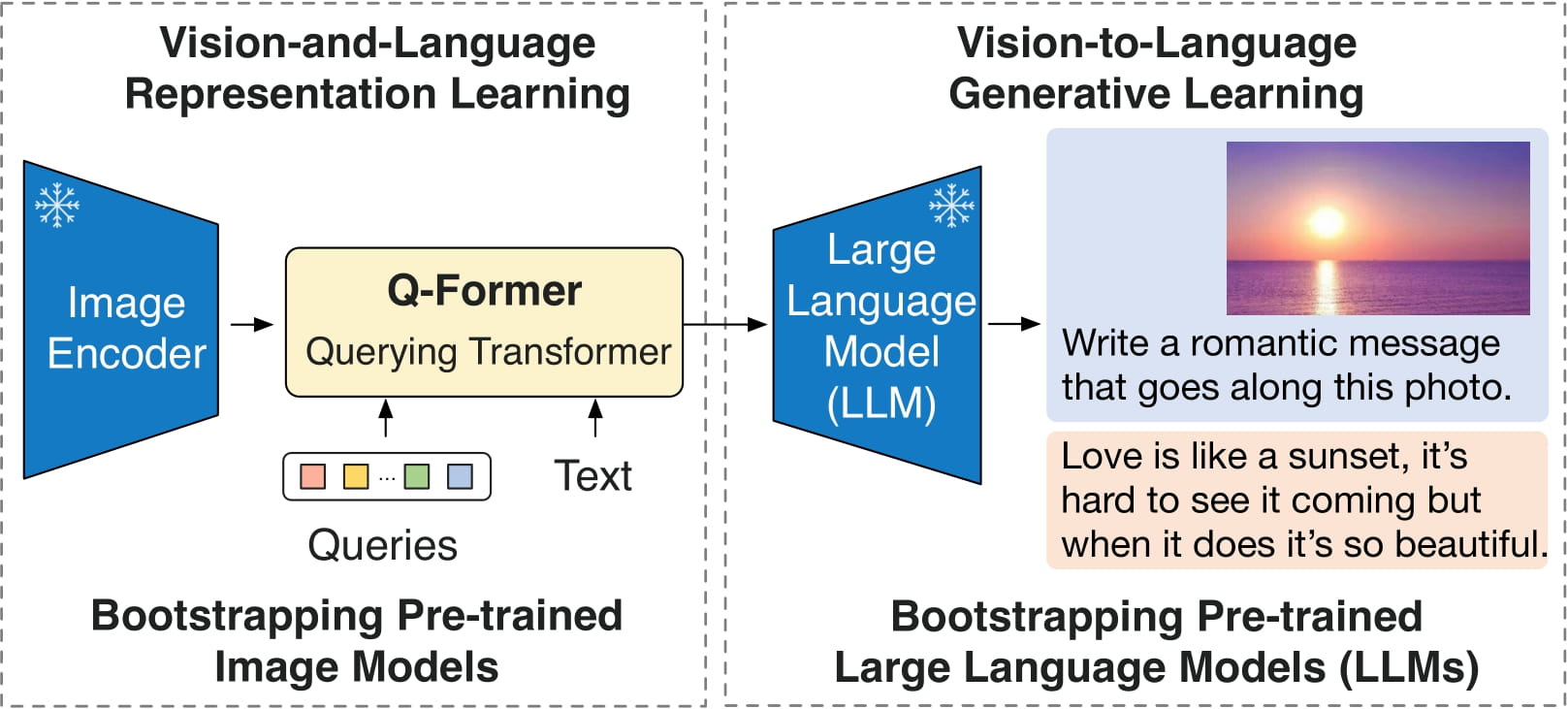Model Overview
Model Features
Model Capabilities
Use Cases
🚀 BLIP-2, OPT-2.7b, pre-trained only
BLIP-2 model leveraging OPT-2.7b, a large language model with 2.7 billion parameters. It can be used for tasks like image captioning, visual question answering, etc.
🚀 Quick Start
BLIP-2 is a powerful model for various vision and language tasks. You can use the raw model for conditional text generation given an image and optional text. Check the model hub for fine - tuned versions on specific tasks.
✨ Features
- Versatile Applications: Can be used for image captioning, visual question answering (VQA), and chat - like conversations.
- Bridge between Image and Text: The Querying Transformer (Q - Former) bridges the gap between the image encoder and the large language model.
📚 Documentation
Model description
BLIP-2 consists of 3 models: a CLIP-like image encoder, a Querying Transformer (Q-Former) and a large language model.
The authors initialize the weights of the image encoder and large language model from pre - trained checkpoints and keep them frozen while training the Querying Transformer, which is a BERT - like Transformer encoder that maps a set of "query tokens" to query embeddings, which bridge the gap between the embedding space of the image encoder and the large language model.
The goal for the model is simply to predict the next text token, giving the query embeddings and the previous text.

This allows the model to be used for tasks like:
- image captioning
- visual question answering (VQA)
- chat - like conversations by feeding the image and the previous conversation as prompt to the model
Direct Use and Downstream Use
You can use the raw model for conditional text generation given an image and optional text. See the model hub to look for fine - tuned versions on a task that interests you.
Bias, Risks, Limitations, and Ethical Considerations
BLIP2-OPT uses off - the - shelf OPT as the language model. It inherits the same risks and limitations as mentioned in Meta's model card.
Like other large language models for which the diversity (or lack thereof) of training data induces downstream impact on the quality of our model, OPT-175B has limitations in terms of bias and safety. OPT-175B can also have quality issues in terms of generation diversity and hallucination. In general, OPT-175B is not immune from the plethora of issues that plague modern large language models.
BLIP2 is fine - tuned on image - text datasets (e.g. LAION) collected from the internet. As a result the model itself is potentially vulnerable to generating equivalently inappropriate content or replicating inherent biases in the underlying data.
BLIP2 has not been tested in real world applications. It should not be directly deployed in any applications. Researchers should first carefully assess the safety and fairness of the model in relation to the specific context they’re being deployed within.
Ethical Considerations
This release is for research purposes only in support of an academic paper. Our models, datasets, and code are not specifically designed or evaluated for all downstream purposes. We strongly recommend users evaluate and address potential concerns related to accuracy, safety, and fairness before deploying this model. We encourage users to consider the common limitations of AI, comply with applicable laws, and leverage best practices when selecting use cases, particularly for high - risk scenarios where errors or misuse could significantly impact people’s lives, rights, or safety. For further guidance on use cases, refer to our AUP and AI AUP.
💻 Usage Examples
Basic Usage
For code examples, refer to the documentation.
Advanced Usage
Memory requirements
The memory requirements differ based on the precision one uses. One can use 4 - bit inference using Bitsandbytes, which greatly reduce the memory requirements.
| Property | Details |
|---|---|
| Model Type | BLIP-2 leveraging OPT-2.7b |
| Training Data | Image - text datasets like LAION |
| dtype | Largest Layer or Residual Group | Total Size | Training using Adam |
|---|---|---|---|
| float32 | 490.94 MB | 14.43 GB | 57.72 GB |
| float16/bfloat16 | 245.47 MB | 7.21 GB | 28.86 GB |
| int8 | 122.73 MB | 3.61 GB | 14.43 GB |
| int4 | 61.37 MB | 1.8 GB | 7.21 GB |
Running the model on CPU
Click to expand
import requests
from PIL import Image
from transformers import Blip2Processor, Blip2ForConditionalGeneration
processor = Blip2Processor.from_pretrained("Salesforce/blip2-opt-2.7b")
model = Blip2ForConditionalGeneration.from_pretrained("Salesforce/blip2-opt-2.7b")
img_url = 'https://storage.googleapis.com/sfr-vision-language-research/BLIP/demo.jpg'
raw_image = Image.open(requests.get(img_url, stream=True).raw).convert('RGB')
question = "how many dogs are in the picture?"
inputs = processor(raw_image, question, return_tensors="pt")
out = model.generate(**inputs)
print(processor.decode(out[0], skip_special_tokens=True).strip())
Running the model on GPU
In full precision
Click to expand
# pip install accelerate
import requests
from PIL import Image
from transformers import Blip2Processor, Blip2ForConditionalGeneration
processor = Blip2Processor.from_pretrained("Salesforce/blip2-opt-2.7b")
model = Blip2ForConditionalGeneration.from_pretrained("Salesforce/blip2-opt-2.7b", device_map="auto")
img_url = 'https://storage.googleapis.com/sfr-vision-language-research/BLIP/demo.jpg'
raw_image = Image.open(requests.get(img_url, stream=True).raw).convert('RGB')
question = "how many dogs are in the picture?"
inputs = processor(raw_image, question, return_tensors="pt").to("cuda")
out = model.generate(**inputs)
print(processor.decode(out[0], skip_special_tokens=True).strip())
In half precision (float16)
Click to expand
# pip install accelerate
import torch
import requests
from PIL import Image
from transformers import Blip2Processor, Blip2ForConditionalGeneration
processor = Blip2Processor.from_pretrained("Salesforce/blip2-opt-2.7b")
model = Blip2ForConditionalGeneration.from_pretrained("Salesforce/blip2-opt-2.7b", torch_dtype=torch.float16, device_map="auto")
img_url = 'https://storage.googleapis.com/sfr-vision-language-research/BLIP/demo.jpg'
raw_image = Image.open(requests.get(img_url, stream=True).raw).convert('RGB')
question = "how many dogs are in the picture?"
inputs = processor(raw_image, question, return_tensors="pt").to("cuda", torch.float16)
out = model.generate(**inputs)
print(processor.decode(out[0], skip_special_tokens=True).strip())
In 8 - bit precision (int8)
Click to expand
# pip install accelerate bitsandbytes
import torch
import requests
from PIL import Image
from transformers import Blip2Processor, Blip2ForConditionalGeneration
processor = Blip2Processor.from_pretrained("Salesforce/blip2-opt-2.7b")
model = Blip2ForConditionalGeneration.from_pretrained("Salesforce/blip2-opt-2.7b", load_in_8bit=True, device_map="auto")
img_url = 'https://storage.googleapis.com/sfr-vision-language-research/BLIP/demo.jpg'
raw_image = Image.open(requests.get(img_url, stream=True).raw).convert('RGB')
question = "how many dogs are in the picture?"
inputs = processor(raw_image, question, return_tensors="pt").to("cuda", torch.float16)
out = model.generate(**inputs)
print(processor.decode(out[0], skip_special_tokens=True).strip())
📄 License
This project is released under the MIT license.
 Transformers
Transformers Transformers
Transformers Transformers
Transformers Transformers English
Transformers English Transformers
Transformers Transformers
Transformers Transformers English
Transformers English